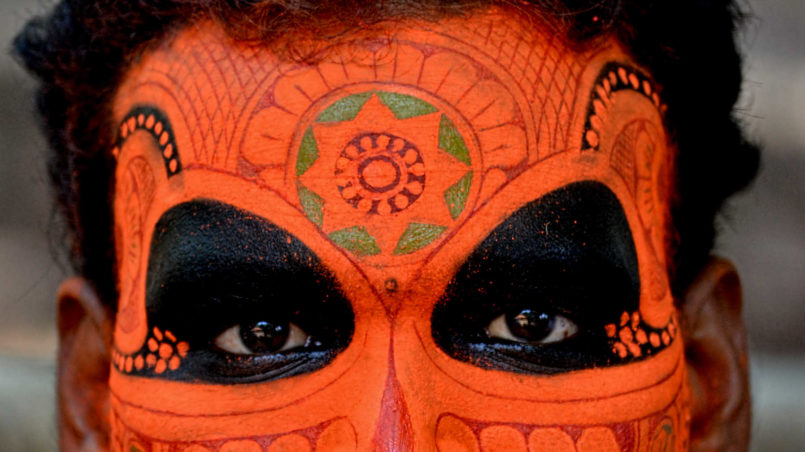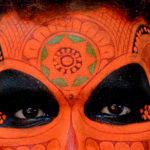The Language of Colors

All that I have seen since I first opened my eyes, all that I see around me and all my memories and images seem to be doused with colors. Everything around me and within me seems drenched in intense shades of red, yellow, saffron, pink, green, blue….! Such a concentrated intensity of colors has always overwhelmed my senses and the impact of colors has been so great, that I don’t think it will ever leave me. I don’t know if we all eventually fall in love with the intense hues of every color but I do believe we cannot imagine a life without color and the way it decodes, connotes and translates into a variety of ideas and belief systems.
Colors and symbolism are intricately connected and abound in the country where I was born: India. Attaching symbolism to colors and the penetration of colors in people’s psyche is obviously not an exclusively Indian phenomenon. Such a phenomenon is intricately weaved into each and every culture. Similarly, in the Indian culture, it seems to shape our beliefs, our everyday conduct, our inhibitions, our choices and may be much more than what I can conceive of right now.
Without even being consciously aware of it, we let social constructions govern the way we perceive and comprehend the world. This phenomenon is so convincing when it comes to the social realm which labels certain colors as indicators of some abstract ideas or belief systems.
From the colors of the clothes Indians wear, to the colors of buildings and houses, to that of billboards, decorations and in fact almost everything reflects the love for intense and bright colors in India. However, the display of colors appears to be at its peak during festivals and weddings.
Most Indian women would love to adorn themselves with brightly colored garments, jewellery and other accessories. I always wondered how the choice of colors with regards to clothes has become one of the indicators to identify married women from those unmarried and widows in India.
I have always been fascinated with the color red. It means so many different things in different settings. My earliest understanding of the color ‘red’ was linked with marriage. The color of vermillion (called sindoor or kumkum), the marker of marriage for Hindu women is red. Almost all married Hindu woman I was surrounded with, use to put the intense red colored vermillion in the mid parting of their hairline.
Usually in my culture, married women and especially brides are supposed to wear red dresses (irrespective of the religion); and young women are usually advised to avoid red clothes. And widows are never to wear the color red. Also Indian women adorn their forehead with bindi (a paste or sticker) of different colors. However, only married women apply red colored bindi on their foreheads. Married women also wear different jewellery that signifies their marital status.
I always wondered why such customs are practised. Why is one color preferred over other colors for a particular ritual and what are the reasons for such a choice? I wanted to know if any such customs make sense. And I always thought, if affixing a particular meaning to a particular color makes sense in my culture, then the same should be equally relevant and comprehensible for people in other cultures.
However, I soon realized that this is not the case and the significance of particular colors in my culture is not universal. Color symbolism is more of a cultural phenomenon.
People from the same culture interpret or make sense of things around them or the world in more or less similar ways. Or we can simply say that members of a culture share the same cultural codes and also decode them in similar ways. Moreover, meanings produced in a particular culture regulate social practices and influence the conduct and beliefs of its members.
The significance of the color red in Indian culture is only comprehensible to, and interpreted in similar ways by members. I came to know as I grew up that in Indian culture (basically in Hinduism) red signifies purity as well as sensuality. It symbolizes the beginning of a new life for a married woman. It is a color full of hope and is used in one form or another on many occasions which are auspicious. In fact the color red is considered a color of worship, as many deities are offered vermillion or red powder during prayers. Even on the death of a married woman, her body is draped with red clothes for cremation.
Since color perceptions are adopted from one culture to another, the overlap of meaning of a particular color in Asian culture is understandable. In the Chinese culture, red symbolizes good fortune, joy, vitality and longevity. In fact red can be found everywhere during New Year celebrations in China. In Japan, the color red is associated with authority and wealth as well as religion and this is demonstrated by the red torii of the Shinto shrines, whose shrine maidens are clad in red hakama. In South Africa, on the other hand, red is the color of mourning. In Western culture, the color red symbolizes a different set of concepts and ideas such as energy, passion, love, etc.
Are colors not merely a natural and material phenomenon? It is our cultures which distinguish one color from another, and assign different words to signify them as well as attach different meanings to them. And the outcome is that colors represent a wide variety of meanings in different cultures. Different colors start to symbolize different concepts and things in different cultures and at times might symbolize different concepts in different settings in the same culture. The way colors inject meaning and shape the understanding of people in one culture might be completely incomprehensible for people from a different culture.
When I use the term language I use it in a much wider sense. It does not merely stand for spoken or written languages like German, Hindi, Chinese or English as such.
According to Stuart Hall,
Language is the privileged medium in which we make sense of things, in which meaning is produced and exchanged.
In that sense, language is a representational system.
The best way to understand this phenomenon of imparting meaning to colors, which then eventually become a part of our subconscious and conscious mind, is by reflecting on how the concept of traffic lights works for all of us. It has become universal in nature. In the domain of traffic conventions, the color red signifies ‘Stop’ and green signifies ‘Go’ and this is universally the case. We rarely need a minute to comprehend the meaning of red and green when we are on the streets.
But the colors red and green also represent a wide variety of completely different meanings in different contexts or settings in the same or different cultures. Only members of the same culture would comprehend similar meanings, as growing up in a particular culture usually provides us with an understanding of the significance of particular colors in our particular culture.
The same is applicable in my case but I realized quite late in my life the way in which colors impart meaning to our beliefs and everyday conduct. In short, a conscious comprehension of how the language of colors works.
Credits
| Image | Title | Author | License |
|---|---|---|---|
 |
Make_up_of_Vishnumoorthi_Theyyam | Mullookkaaran | CC BY-SA 3.0 |
